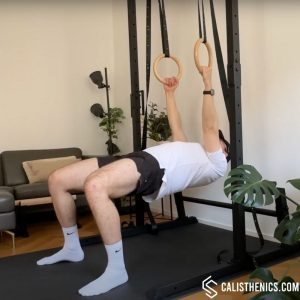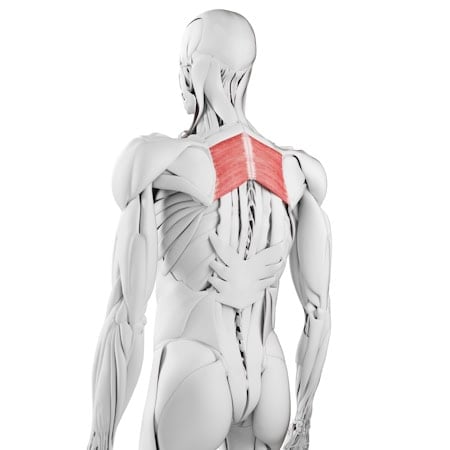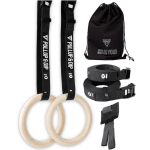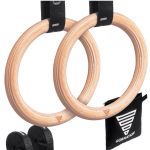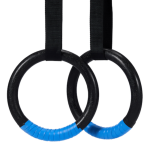Ring Scapula Row
How to do Ring Scapula Row?
The ring scapula row is a fundamental calisthenics exercise that targets scapular strength and stability using gymnastics rings. It involves retracting and protracting the shoulder blades while maintaining a stable core, making it an excellent movement for improving scapular control, posture, and pulling strength. Unlike regular rows, the focus is solely on moving the shoulder blades without bending the elbows.
This exercise requires basic scapular mobility and control. While no prior pulling strength is necessary, a foundational ability to engage the scapulae properly is essential. It can be performed with bent knees (easier variation) or straight legs (harder variation) to adjust the difficulty. The rings provide an added challenge by demanding greater stability, engaging the core and smaller stabilizing muscles throughout the movement.
To perform the ring scapula row, you’ll need a pair of gymnastics rings set at an adjustable height. No additional equipment is required, but wearing grippy shoes or performing the exercise on a non-slip surface can enhance stability. This movement serves as a valuable accessory exercise for pull-ups, rows, and other calisthenics pulling movements.
How to Perform the Ring Scapula Row
1. Setup Position:
• Adjust the gymnastics rings to about waist height or lower for increased difficulty.
• Hold the rings with a neutral grip (palms facing each other) and lean back, extending your arms fully.
• Your body should form a straight line from your head to your heels if using straight legs or to your knees if keeping them bent.
• Engage your core and glutes to maintain a rigid body position.
2. Initiating the Movement:
• Without bending your elbows, retract your shoulder blades by squeezing them together.
• Your chest should rise slightly as your scapulae pull back, but your arms remain straight.
3. Protraction Phase:
• Slowly return to the starting position by allowing your shoulder blades to protract (move apart) fully.
• Ensure a full range of motion by letting your shoulders glide forward while maintaining tension.
4. Repetition and Breathing:
• Perform the movement in a slow, controlled manner.
• Inhale as you protract the scapulae, and exhale as you retract them.
Benefits of the Ring Scapula Row
• Improves scapular strength and control, essential for pull-ups and rows.
• Enhances shoulder stability, reducing the risk of shoulder impingement and injuries.
• Develops core engagement, as maintaining a stable body position strengthens the core.
• Builds foundational pulling strength, serving as a prerequisite for strict pull-ups and explosive pulling movements.
• Increases posture awareness, helping to counteract rounded shoulders from daily activities.
Common Mistakes to Avoid
❌ Bending the elbows: Keep your arms fully extended; the movement should only come from the scapulae.
❌ Using momentum: Avoid jerking movements. Perform slow, controlled reps for maximum benefit.
❌ Losing core engagement: Keep your body in a straight line without sagging at the hips.
❌ Partial range of motion: Ensure full scapular retraction and protraction for proper muscle activation.
❌ Shrugging the shoulders: The movement should come from the scapulae, not the traps.
Tips for the proper execution of Ring Scapula Row
Keep your body in a rigid plank position to maximize stability.
Engage your lats throughout the movement to maintain control.
Perform the exercise slowly, focusing on mind-muscle connection.
If you’re new to scapular control, practice hanging scapular retractions first.
Use controlled breathing to maintain core engagement and stability.
Keep your neck neutral—avoid tucking or craning it forward.
Muscles worked when doing Ring Scapula Row
Primary Muscles: Lower and middle trapezius, rhomboids, serratus anterior
•Secondary Muscles: Latissimus dorsi, rear deltoids, core stabilizers
The lower and middle trapezius and rhomboids are engaged during scapular retraction, while the serratus anterior activates during protraction. The lats and rear delts contribute to stabilizing the shoulder joint, while the core maintains body tension.
Primary Muscle(s):
Secondary Muscle(s):
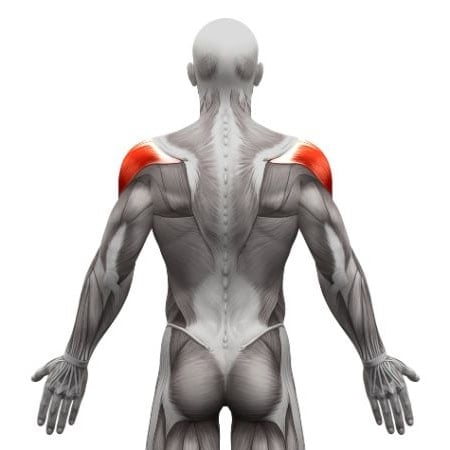
Rear delt
Adjust the difficulty of Ring Scapula Row
How to make Ring Scapula Row harder?
How to make Ring Scapula Row easier?
How to make Ring Scapula Row harder?
To make Ring Scapula Row harder:
-
Straighten your legs to increase the difficulty by shifting more body weight onto the rings.
-
Lower the rings to create a more horizontal body position, making it more challenging.
-
Elevate your feet on a box or bench to increase resistance.
-
Add a weighted vest for extra load once bodyweight mastery is achieved.
-
Perform a slow eccentric phase, emphasizing control on the way down.
How to make Ring Scapula Row easier?
To make Ring Scapula Row easier:
-
Bend your knees to reduce the leverage and decrease resistance.
-
Raise the rings higher to place more of your body weight on your feet.
-
Perform standing scapular retractions before attempting the full movement.
-
Use a slower tempo to focus on control rather than intensity.

